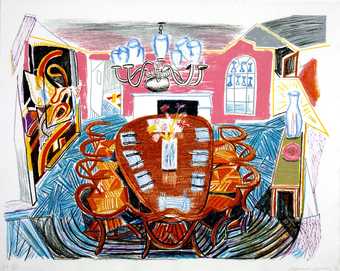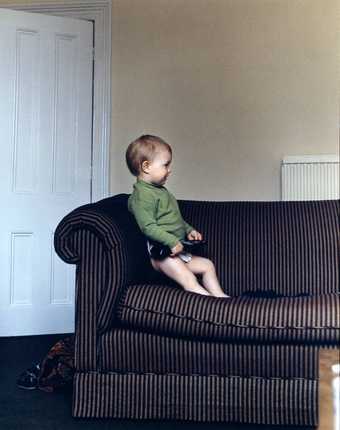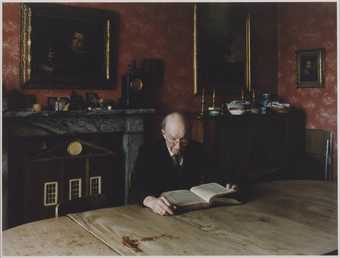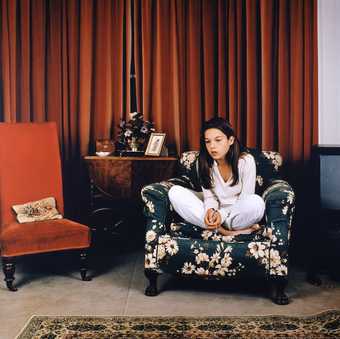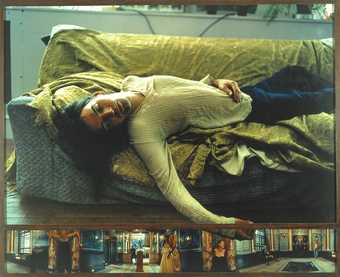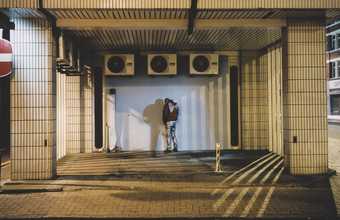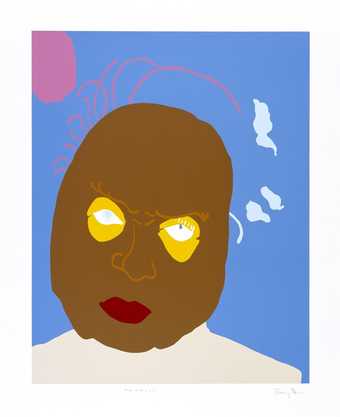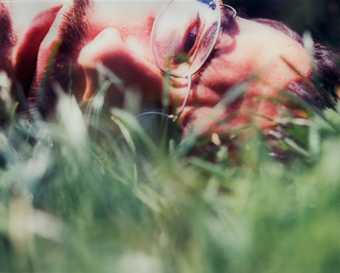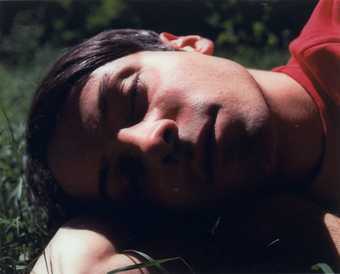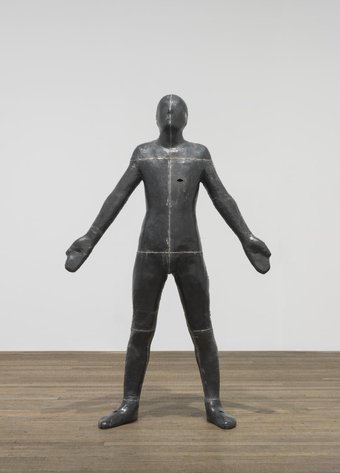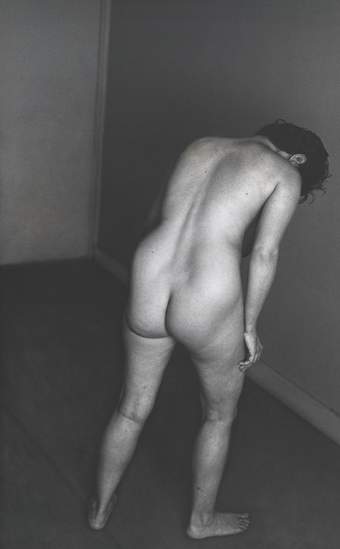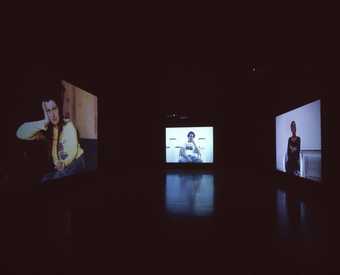
Not on display
- Artist
- Sarah Jones born 1959
- Medium
- Photograph, colour, on paper on aluminium
- Dimensions
- Image: 1500 × 1500 mm
- Collection
- Tate
- Acquisition
- Purchased 1999
- Reference
- P78252
Summary
The Dining Room (Francis Place) I is a large, square photograph. It depicts three teenage girls posed formally in a dining room in a balanced composition. The image is scaled up to almost life size. In the centre, a clock face in a housing resembling a classical temple stands on a dark marble fireplace. Above the clock hangs a nineteenth century portrait of a grey-haired man mounted in a heavy gilt frame. On either side of the painting, framed prints of men hunting on horseback hang at equal distance. The image is dominated by the colour of the wall behind, a brilliant, rich turquoise. In the midground, the polished surface of the dining table cuts across the picture horizontally. At its centre, in line with and directly below the portrait, clock, and fireplace, an ornate ceramic tureen stands on a large silver platter, which is raised up on curved legs. The tureen bears blue paintwork of oriental scenes which are echoed in the style of ceramic plates on the mantelpiece and a vase on furniture in the background. A dark-haired girl stands to the centre right of the image, holding onto the back of a chair pulled out behind the table. She stares directly, but inscrutably, at the viewer. Two girls sit at the table, on either side of its centrepiece. On the right, a girl wearing a turquoise shirt is gazing at the tureen. One hand rests lightly on the table. The other, half hidden behind a cascade of tawny hair, supports her face as she leans her elbow on the table. On the left, a girl in a red shirt is folded over her arms, her face hidden and her blonde hair flowing luxuriously onto the table. The table’s surface is highly reflective, expanding the space and mirroring the girls. The dark space underneath it constitutes the foreground of the image and takes up approximately one quarter of the picture frame. It contributes significantly to the visual power of the image and adds a sinister undertone to metaphoric readings of the girls and their environment. The girls wear make up and are well groomed, echoing the room’s extremely clean and well-ordered appearance.
The Dining Room (Francis Place) I and a related photograph, The Sitting Room (Francis Place) III 1997 (Tate P78250), are the result of an ongoing project Jones began in 1996 with the assistance of three teenage girls, Camilla, Rohan and Stephanie. She has photographed them in two of their parental homes, Francis Place and Mulberry Lodge, large, comfortable houses located in a village in middle England. The girls are close friends and well known to the artist. They were fourteen at the time The Dining Room (Francis Place) I was made. Jones began photographing them in the dining rooms and sitting rooms of the two houses. She subsequently expanded her series into the landing, the hallway, the spare room, a bedroom and the garden. The images are carefully set up, the furniture often rearranged and studio lights used, enhancing the staged atmosphere. Jones’s work is informed by the writings of psychoanalysts Sigmund Freud (1856-1939), Jacques Lacan (1901-81) and philosopher Roland Barthes (1915-80). In an earlier series of photographs, Actor I-IV 1995, Jones invited a group of professional actors to select and emulate one of six gazes depicted in a painting by Italian renaissance artist Piero della Francesca (1420?-92), known as the Montefeltro
Altarpiece (1465). In this project she explored the relationships between a staged pose or gesture, a gaze and a person’s individual character. With the Francis Place/Mulberry Lodge series, she extends this theme with a mixture of opposites. Each image is openly contrived, the result of careful composition and artificial, directed poses. At the same time, the girls are personal friends, both of the artist and amongst themselves. These relationships must, necessarily, affect the nature of the photograph. The rooms in which they are photographed are located in a home known intimately to them. As the series progresses and photographs are taken over formative years in the girls’ lives, their mid adolescence, their appearances change. The creation of identity through appearance is a central preoccupation for teenagers and the series partially documents these changes. Other readings, such as narrative subtexts, are hinted at by the images, but remain impenetrable. The girls belong to affluent, upper-middle class families, their homes ornamented with the symbols of wealth and status. Beneath the painted patriarch’s benevolent gaze, they appear awkward, uncomfortable, bored or even mentally absent, departed in adolescent reverie. Their relationship to the environment which supports and nurtures them is ambiguous. The titles of these works all refer to the place, rather than the human subjects of the image, suggesting a theatrical tableau rather than a portrait. The images lie in between a reality which is described and one which is performed, confronting the viewer with questions about photographic representation.
The Dining Room (Francis Place) I was produced in an edition of three plus one artist’s proof.
Further reading:
Chris Townsend, ‘Openings, Sarah Jones’, Artforum, vol. 36, no.7, March 1998, pp.90-1
Sarah Jones, exhibition catalogue, Museum Folkwang, Essen and Huis Marseille Foundation of Photography, Amsterdam 2000, reproduced (colour) p.53
Sarah Jones, exhibition brochure, Jerwood Gallery, London 1999
Mo Thorp, ‘Dark Underside’, make, no.76, June-July 1997, p.26, reproduced (colour) p.26
Elizabeth Manchester
January 2003
Does this text contain inaccurate information or language that you feel we should improve or change? We would like to hear from you.
Display caption
In 1997 Jones began three large series of photographs entitled The Dining Room, The Sitting Room and The Garden. As the titles suggest, each series features a quintessentially English domestic setting. Jones worked with three teenage girls, near neighbours and close friends, photographing them repeatedly in closely related compositions that highlight the restless tension which, for many, characterises the experience of adolescence. Although the sitters frequently appear together, they rarely seem to interact, either with each other or their surroundings. Jones's compositions are carefully constructed using formal devices traditionally associated with painting, such as reflections and an underlying symmetry.
Gallery label, September 2004
Does this text contain inaccurate information or language that you feel we should improve or change? We would like to hear from you.
Explore
- emotions, concepts and ideas(16,416)
-
- emotions and human qualities(5,345)
-
- boredom(50)
- formal qualities(12,454)
-
- photographic(4,673)
- domestic(1,795)
-
- dining room(64)
- fine arts and music(3,982)
-
- painting(473)
- tureen(3)
- actions: postures and motions(9,111)
-
- head in hand / hands(278)
- standing(3,106)
- girl(1,079)
- birth to death(1,472)
-
- youth(193)
You might like
-
David Hockney Tyler Dining Room
1984 -
Paul Graham Television Portrait (Danny, Bristol)
1991 -
Thomas Struth The Late Giles Robertson (with Book), Edinburgh 1987
1987 -
Thomas Struth The Smith Family, Fife, Scotland 1989
1989 -
Sarah Jones The Sitting Room (Francis Place) III
1997 -
Sarah Jones The Garden (Mulberry Lodge) VI
1997 -
Sam Taylor-Johnson OBE Soliloquy I
1998 -
Rineke Dijkstra De Panne, Belgium, August 7 1992
1992 -
Seamus Nicolson Ori
1999 -
Gary Hume Francis Bacon
1998 -
Phil Collins young serbs (bojan)
2001 -
Phil Collins young serbs (siniša)
2001 -
Sir Antony Gormley OBE RA Untitled (for Francis)
1985 -
Craigie Horsfield E. Horsfield, Well Street, East London, March 1986
1992 -
Sam Taylor-Johnson OBE Killing Time
1994

